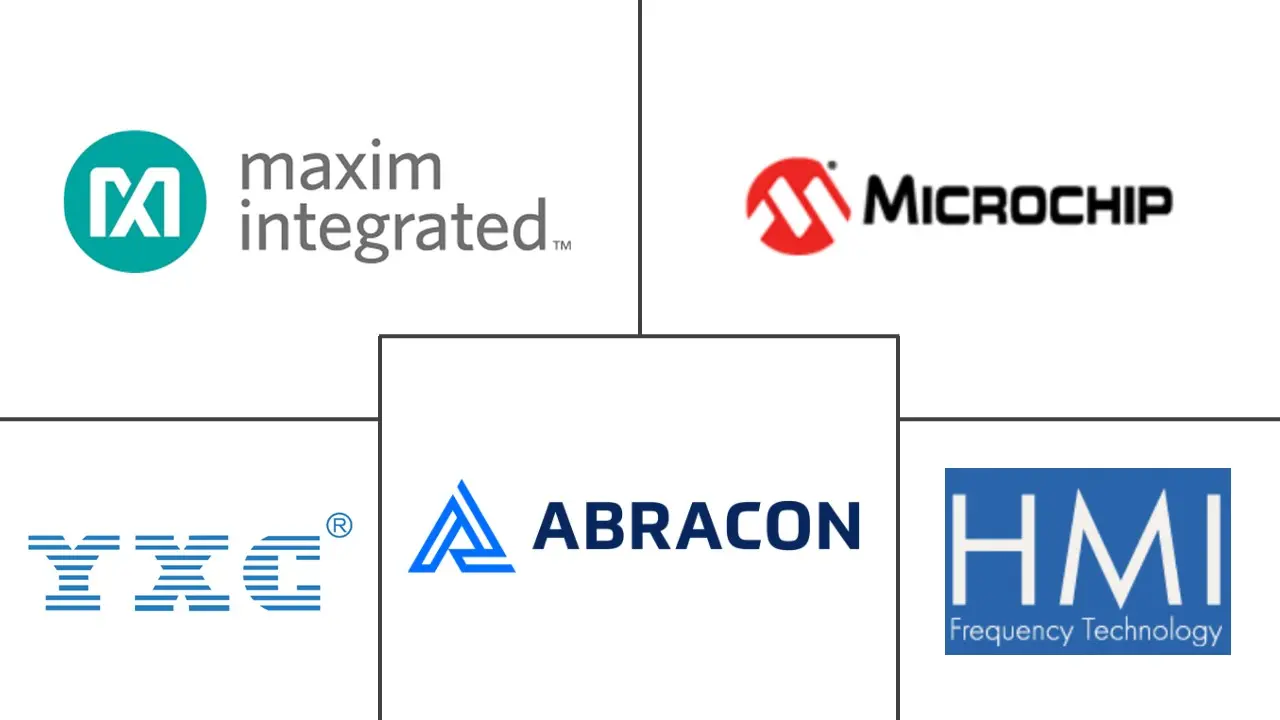MEMS-based Oscillator Market Size and Share
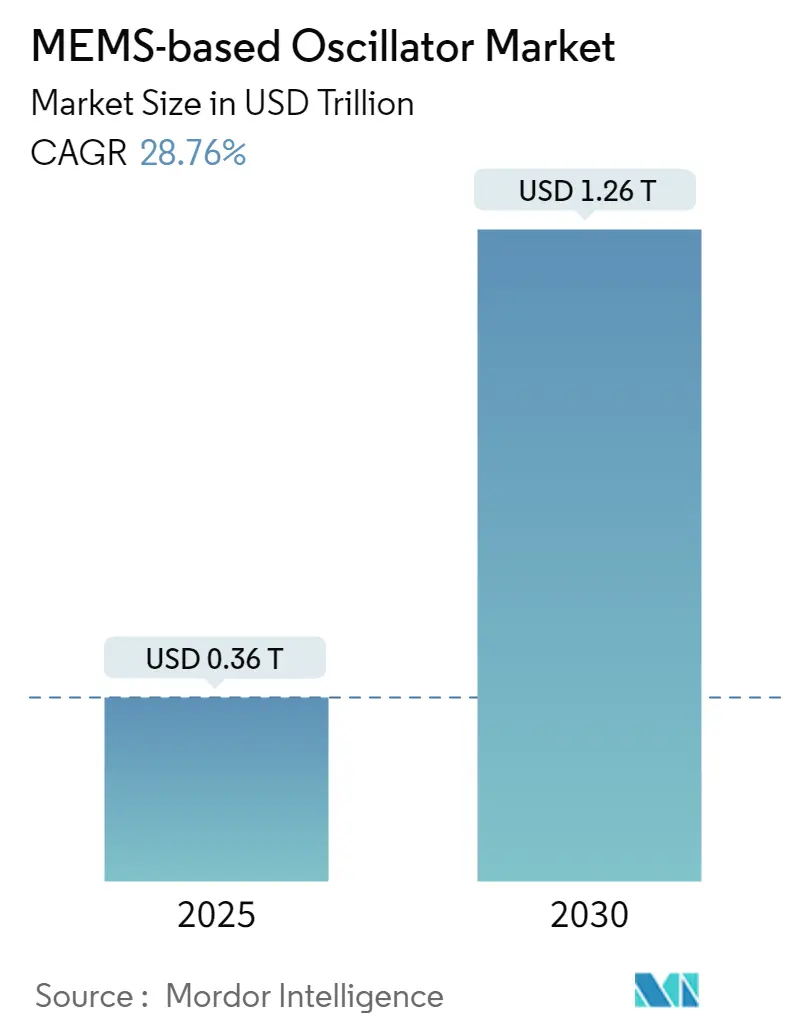
MEMS-based Oscillator Market Analysis by Mordor Intelligence
The MEMS-based Oscillator Market size is estimated at USD 0.36 trillion in 2025, and is expected to reach USD 1.26 trillion by 2030, at a CAGR of 28.76% during the forecast period (2025-2030).
The MEMS-based oscillator industry is undergoing a rapid transformation driven by the convergence of multiple technology sectors and an increasing demand for precise timing solutions. The integration of MEMS-based oscillators into emerging technologies has become crucial for maintaining accurate precision timing and frequency control in various electronic devices. These oscillators are increasingly being adopted in applications ranging from consumer electronics to industrial automation, owing to their superior performance characteristics, including high resistance to mechanical shock, vibration, and temperature variations. According to industry projections, the global number of connected wearable devices is expected to surpass one billion units by 2024, highlighting the growing importance of reliable timing solutions in consumer technology.
Product miniaturization and performance enhancement continue to reshape the competitive landscape, with manufacturers focusing on developing innovative solutions for space-constrained applications. MEMS-based oscillators are gaining significant traction in the medical devices sector, where their compact size and low power consumption make them ideal for portable and wearable healthcare devices. The medical device industry's robust growth trajectory is evidenced by projections indicating that exports could reach USD 10 billion by 2025, creating substantial opportunities for MEMS-based oscillator integration in healthcare applications.
The automotive sector is witnessing a paradigm shift with the increasing adoption of advanced driver assistance systems (ADAS) and autonomous driving technologies. MEMS-based oscillators are becoming essential components in these systems, providing precise timing for safety-critical applications and enhanced vehicle connectivity. In 2023, major automotive manufacturers have accelerated their investments in electric and autonomous vehicle development, driving demand for high-performance timing components that can withstand harsh automotive environments while maintaining exceptional accuracy.
The telecommunications infrastructure is undergoing significant transformation with the deployment of 5G networks and edge computing facilities. MEMS-based oscillators are playing a crucial role in enabling high-speed data transmission and network synchronization. Recent developments in 2024 include the launch of advanced MEMS timing solutions specifically designed for 5G infrastructure, offering improved phase noise performance and better stability under varying environmental conditions. These innovations are particularly significant for outdoor 5G radio installations, where environmental stressors can significantly impact traditional electronic timing solutions.
Global MEMS-based Oscillator Market Trends and Insights
Advancement in Silicon-Based Manufacturing and Packaging Techniques
The continuous evolution of silicon-based manufacturing and packaging techniques has revolutionized the MEMS-based oscillator industry by enabling superior process technology for resonator design. Silicon MEMS technology has demonstrated remarkable capabilities in integrating with other circuits across standard semiconductor packages, making scalable traditional silicon manufacturing possible for both resonator and broader timing technology. These manufacturing advances have enabled MEMS-based oscillators to operate across a wide range of frequencies while maintaining high resistance to mechanical shock, vibration, and temperature changes, and demonstrating reduced susceptibility to frequency jumps. For instance, modern MEMS-based oscillators can support frequencies ranging from 1 MHz to 150 MHz, with supply voltages between 1.8 V and 3.3 V DC, and temperature ranges of up to -40°C to 105°C, showcasing the versatility achieved through advanced manufacturing techniques.
The implementation of sophisticated silicon-based packaging and manufacturing processes has led to significant improvements in timing solutions that are compact in size while offering enhanced robustness, high performance, and programmability. This advancement is exemplified by developments such as X-Fab Silicon Foundries SE's integration of microfluidic components into their complementary CMOS and silicon on insulator (SOI) wafer manufacturing for MEMS-based technology. These manufacturing innovations have opened new possibilities for MEMS-based applications across various sectors, including drug administration, flow metering, and pollution monitoring systems. Furthermore, silicon-based timing solutions have proven particularly beneficial in several end markets, including telecommunications, industrial, automotive, IoT, and mobile applications, where they enable greater functionality compared to legacy solutions while maintaining precise timing accuracy and reliability. The integration of silicon oscillator technology has further enhanced these applications, providing a reliable frequency reference that supports diverse operational requirements.
Segment Analysis
Temperature Compensated Oscillator (TCXO) Segment in MEMS-based Oscillator Market
The Temperature Compensated Oscillator (TCXO) segment has emerged as the dominant force in the MEMS-based oscillator market, driven by its extensive adoption across multiple industries. These oscillators are particularly preferred in applications where a precision frequency source is required within a small space and at low cost. The segment's leadership position is reinforced by its superior performance characteristics, including sustainability in harsh working environments, improved aging resistance, enhanced mechanical vibration tolerance, and minimal frequency shifts. TCXOs are gaining significant traction in communications and cloud infrastructure devices, offering 10x better dynamic stability and replacing costly OCXOs in IEEE 1588 applications. The growing deployment of 5G networks has further strengthened this segment's position, as MEMS TCXOs demonstrate superior performance in outdoor 5G radios by maintaining frequency stability even under challenging environmental conditions.
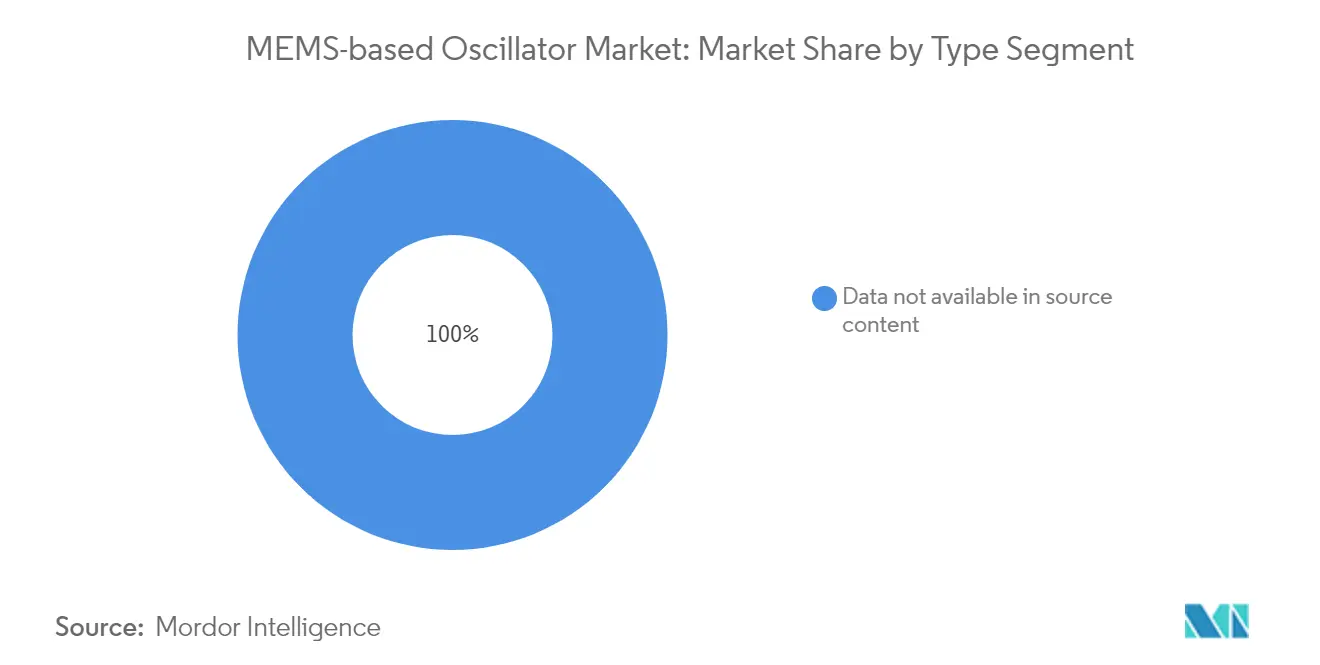
Voltage Control Oscillator (VCXO) Segment in MEMS-based Oscillator Market
The Voltage Control Oscillator (VCXO) segment is experiencing the fastest growth trajectory in the MEMS-based oscillator market, driven by increasing demands in telecommunications and advanced networking applications. These oscillators are proving crucial for low-bandwidth PLLs, which are extensively used for synchronization and jitter cleanup in telecom, video, audio, networking, and instrumentation applications. The segment's growth is particularly accelerated by its exceptional dynamic performance and reliability characteristics in telecom, networking, video distribution (CMTS), and instrumentation applications. VCXOs maintain consistent phase noise and frequency tuning accuracies even in harsh environmental conditions like vibrations, EMI, shock, and noisy power supply, making them ideal for equipment such as cable headend and remote radio head (RRH) installations in uncontrolled environments like un-airconditioned rooftops or basements.
Remaining Segments in MEMS-based Oscillator Market by Type
The market's remaining segments, including Spread Spectrum Oscillators (SSXO), Digitally Controlled Oscillators (DCXO), and other specialized types, each serve unique applications in the MEMS-based oscillator ecosystem. SSXOs are particularly valuable in reducing electromagnetic interference in consumer electronics and industrial applications, while DCXOs offer enhanced flexibility through digital interfaces for frequency programming and control. These segments continue to evolve with technological advancements, offering innovative solutions for specific application requirements such as EMI reduction, frequency agility, and multi-protocol serial interfaces. The diversity of these segments ensures comprehensive coverage of various timing requirements across different industries, from consumer electronics to industrial automation. The clock oscillator and clock generator technologies are integral to these advancements, providing precise timing solutions across diverse applications.
Segment Analysis: By End User Industry
Consumer Electronics Segment in MEMS-based Oscillator Market
The Consumer Electronics segment maintains its dominant position in the MEMS-based oscillator market, commanding approximately 32% of the market share in 2024. This leadership is primarily driven by the increasing integration of MEMS-based oscillators in a wide range of consumer electronic devices, including smartphones, smartwatches, wearables, and IoT devices. The segment's growth is further supported by the continuous advancement in portable and wearable electronics, which drives the need to reduce energy consumption and footprint of electronic components, especially oscillators. MEMS-based oscillators offer an appealing combination of low power consumption, small size, high performance, and physical robustness, making them ideal for numerous applications in consumer electronics. The role of frequency control devices in enhancing the performance of these electronics cannot be overstated, as they ensure precise timing and synchronization.
Automotive Segment in MEMS-based Oscillator Market
The Automotive segment is emerging as the fastest-growing sector in the MEMS-based oscillator market, with an expected growth rate of approximately 19% from 2024 to 2029. This remarkable growth is attributed to the increasing adoption of advanced driver assistance systems (ADAS), autonomous vehicles, and electric vehicles globally. MEMS-based oscillators are becoming crucial components in automotive applications, including brake controls, anti-lock braking systems, airbags, and tire-pressure monitoring systems. The superior performance of MEMS-based oscillators in harsh automotive environments, including their resistance to shock, vibration, and temperature variations, makes them particularly suitable for these applications. The growing trend toward vehicle electrification and autonomous driving capabilities is expected to further accelerate the demand for MEMS-based oscillators in the automotive sector, significantly impacting the crystal oscillator market.
Remaining Segments in MEMS-based Oscillator Market
The remaining segments, including IT and Telecom, Aerospace and Defense, and Other End-user Industries, continue to play vital roles in shaping the MEMS-based oscillator market. The IT and Telecom sector is particularly significant, driven by the ongoing deployment of 5G infrastructure and the increasing demand for high-performance timing solutions in data centers and network equipment. The Aerospace and Defense segment benefits from the growing need for highly reliable timing devices in military communications, radar systems, and satellite applications. Other end-user industries, including medical devices and industrial applications, contribute to the market's diversity by implementing MEMS-based oscillators in specialized applications requiring precise timing and reliability.
Geography Analysis
MEMS-based Oscillator Market in North America
North America represents a significant market for the MEMS-based oscillator market, commanding approximately 23% of the global market share in 2024. The region maintains its position as a primary hub for technological innovation and adoption, supported by the strong presence of major MEMS-based oscillator manufacturers like Maxim Integrated Products Inc., Microchip Technology Inc., and SiTime Corporation. The market is primarily driven by the increasing adoption of MEMS-based oscillators in wearable technology, IoT devices, and advanced automotive applications. The region's robust semiconductor manufacturing infrastructure, coupled with substantial investments in research and development activities, continues to foster innovation in MEMS-based oscillator technology. The presence of a mature consumer electronics sector and early adoption of emerging technologies, such as 5G and autonomous vehicles, further strengthens the market position. Additionally, the strong focus on aerospace and defense applications, where precision oscillator solutions are crucial, significantly contributes to market growth in the region.
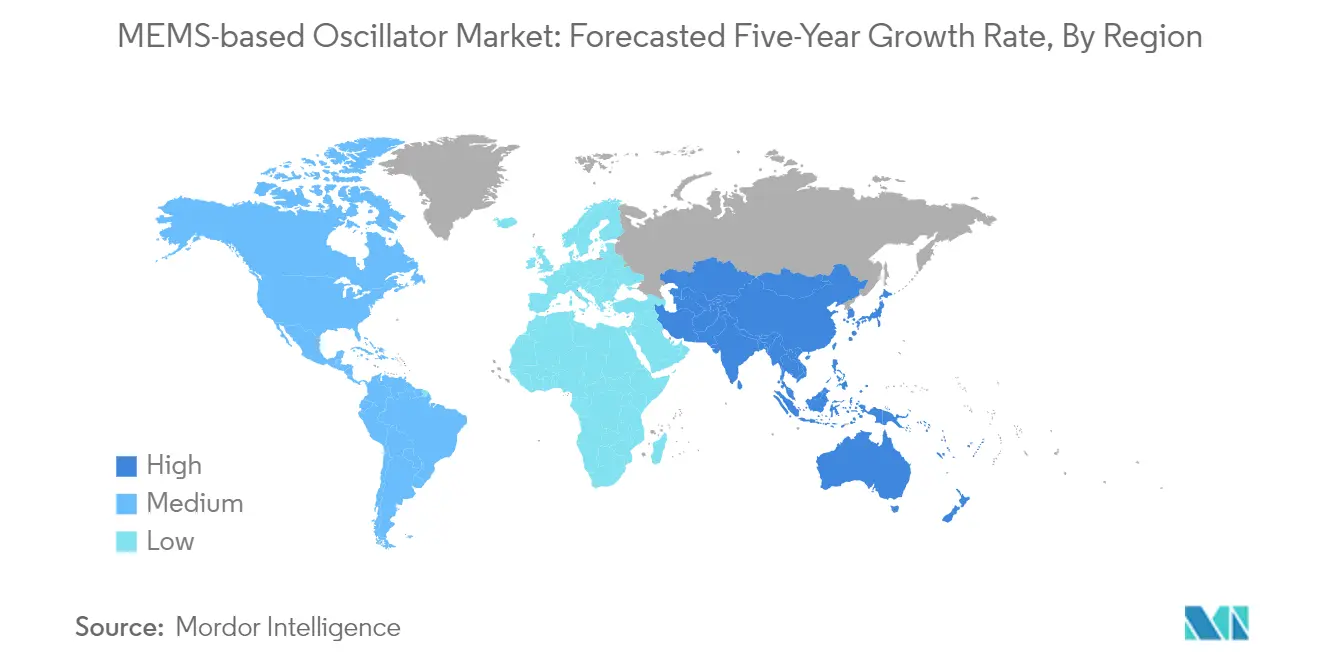
MEMS-based Oscillator Market in Europe
The European MEMS-based oscillator market has demonstrated robust growth, with an estimated annual growth rate of approximately 17% from 2019 to 2024. The region's market is characterized by its strong focus on industrial automation, automotive applications, and telecommunications infrastructure. European manufacturers are increasingly incorporating MEMS-based oscillators into their production processes, particularly in countries such as Germany, France, and the United Kingdom. The region's stringent quality standards and regulatory framework have encouraged the development of high-precision MEMS timing solutions. The automotive sector, particularly the growing electric vehicle market, has emerged as a significant driver for MEMS-based oscillator adoption. The presence of established research institutions and technological centers has facilitated continuous innovation in MEMS technology. Furthermore, the region's focus on Industry 4.0 initiatives and smart manufacturing has created additional demand for precise timing solutions in industrial applications.
MEMS-based Oscillator Market in Asia Pacific
The Asia Pacific region continues to dominate the global MEMS-based oscillator market, with a projected growth rate of approximately 18% from 2024 to 2029. The presence of major electronics manufacturing hubs in countries like China, Japan, South Korea, and Taiwan primarily shapes the region's market dynamics. The rapid expansion of 5G infrastructure, coupled with the increasing production of smartphones and consumer electronics, drives substantial demand for MEMS-based oscillators. The region benefits from a robust supply chain ecosystem and advanced manufacturing capabilities, particularly in semiconductor fabrication. The growing adoption of IoT devices and smart wearables in countries like India and China further accelerates market growth. The presence of key manufacturers and ongoing investments in research and development facilities strengthen the region's position as a global leader in MEMS-based oscillator production. Additionally, government initiatives supporting electronics manufacturing and technological innovation contribute to the market's expansion.
MEMS-based Oscillator Market in Rest of the World
The Rest of the World region, encompassing Latin America, the Middle East, and Africa, represents an emerging market for MEMS-based oscillators with significant growth potential. These regions are witnessing increasing adoption of MEMS-based oscillators driven by the growing penetration of smartphones, wearable devices, and industrial automation systems. The market in these regions is particularly influenced by the expanding telecommunications infrastructure and the gradual shift towards advanced manufacturing capabilities. Countries in the Middle East are showing particular interest in MEMS-based oscillators for applications in smart city projects and defense systems. Latin American countries are experiencing growing demand for consumer electronics and automotive applications. The increasing focus on industrial modernization and digital transformation initiatives in these regions creates new opportunities for MEMS-based oscillator applications. Furthermore, the growing investment in healthcare infrastructure and medical devices across these regions is expected to create additional demand for precision timing solutions.
Competitive Landscape
Top Companies in MEMS-based Oscillator Market
The competitive landscape is characterized by continuous product innovation and strategic investments from key players, including SiTime Corporation, Microchip Technology, Maxim Integrated, Daishinku Corporation, and Rakon Limited. Companies are focusing on developing advanced MEMS-based oscillator solutions with improved stability, lower power consumption, and enhanced performance characteristics to meet evolving industry demands. Strategic partnerships with semiconductor manufacturers and distributors have become crucial for ensuring reliable supply chains and expanding market reach. The industry has witnessed significant investments in research and development activities, particularly in areas like 5G infrastructure, automotive applications, and IoT devices. Companies are also emphasizing operational agility through outsourced manufacturing models while maintaining strong quality control measures and establishing a regional presence through distribution networks.
Consolidated Market with Strong Regional Players
The MEMS-based oscillator market exhibits a relatively consolidated structure with a mix of global technology conglomerates and specialized manufacturers. Major players have established strong manufacturing partnerships and distribution networks across key regions, particularly in Asia-Pacific countries like China, Taiwan, and Japan. The market has witnessed notable merger and acquisition activities, such as Analog Devices' acquisition of Maxim Integrated, which has further consolidated the competitive landscape. These strategic moves have enabled companies to expand their technological capabilities, strengthen their product portfolios, and enhance their market presence across different geographical regions.
The competitive dynamics are shaped by the presence of both established semiconductor manufacturers and specialized MEMS technology providers. While global conglomerates leverage their extensive resources and established customer relationships, specialized players compete through focused innovation and customized solutions for specific applications. The industry has seen increasing collaboration between manufacturers and end-users, particularly in developing application-specific solutions for emerging technologies like 5G, autonomous vehicles, and industrial IoT applications. Regional players, especially in Asia, are gaining prominence through cost-effective manufacturing capabilities and strong local market understanding.
Innovation and Customization Drive Market Success
Success in the MEMS-based oscillator market increasingly depends on companies' ability to deliver customized solutions while maintaining cost competitiveness. Incumbent players are focusing on expanding their product portfolios through continuous innovation, particularly in areas like low-power consumption, improved stability, and miniaturization. Strategic partnerships with key end-users in telecommunications, automotive, and consumer electronics sectors have become crucial for maintaining market position. Companies are also investing in advanced manufacturing capabilities and quality control measures to meet stringent industry requirements and regulatory standards.
For contenders looking to gain market share, differentiation through specialized applications and focused market segments offers a viable strategy. The increasing demand for application-specific solutions in emerging technologies presents opportunities for new entrants with innovative technologies. Success factors include developing strong intellectual property portfolios, establishing reliable manufacturing partnerships, and building effective distribution networks. While substitution risks from traditional quartz oscillators exist, the superior performance characteristics of MEMS-based solutions in specific applications provide a competitive advantage. Companies must also navigate evolving regulatory requirements, particularly in automotive and telecommunications applications, while maintaining cost competitiveness and operational efficiency.
MEMS-based Oscillator Industry Leaders
-
Maxim Integrated Products Inc. (Analog Devices Inc.)
-
Microchip Technology Inc.
-
HMI Frequency Technology
-
Shenzhen Yangxing Technology Co. Ltd
-
Abracon LLC
- *Disclaimer: Major Players sorted in no particular order
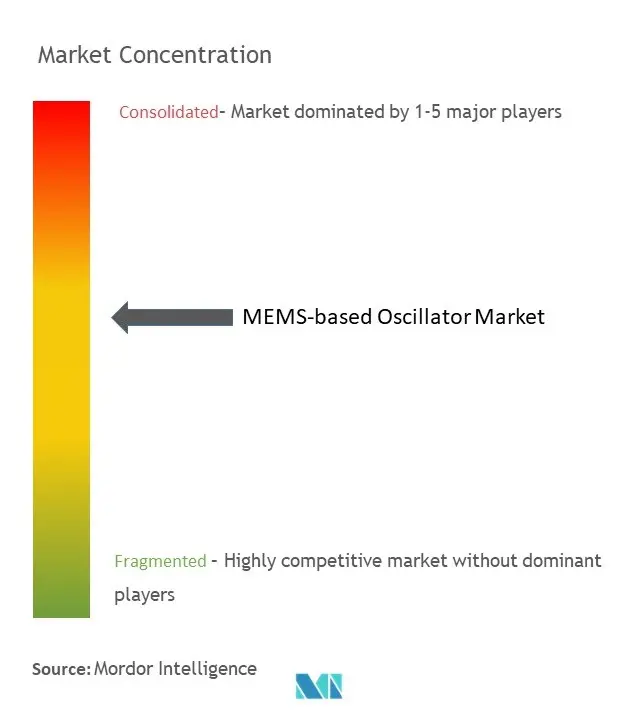
Recent Industry Developments
- November 2022: Rakon introduced equipment for Hi-Rel Space Master Reference Oscillators with 100ppb frequency stability for GEO telecommunication satellites, where accuracy, frequency stability, and extremely low phase noise are critical. The equipment is based on a 3:1 redundancy architecture, with output frequencies ranging from 5 to 200 MHz.
- November 2022: SiTime Corp. introduced the SiT5503 Elite XTM Super-TCXO, which improves timing efficiency in data centers and 5G infrastructure. The potential market for precise timing in communications enterprise is anticipated to reach USD 1.3 billion by 2024. The SiT5503 Elite X Super-TCXO will target the USD 200 million market by providing an unrivaled mix of capabilities and speed that enables quicker, more dependable networks.
- September 2022: Rakon Limited launched the RK409AVNS, a new Ultra Stable Oscillator (USO) with a high Allan Deviation (ADEV) of 2.5 x 10-13. The expanding need for Low Earth Orbit (LEO) PNT (Positioning, Navigation, and Timing) constellations alongside a crucial need for high-accurate frequency output signals is addressed by this device.
Global MEMS-based Oscillator Market Report Scope
The MEMS-Based Oscillator Market categorizes the industry by Type, featuring Temperature Compensated Oscillators (TCXO), Spread Spectrum Oscillators (SSXO), Voltage Control Oscillators (VCXO), Digitally Controlled Oscillators (DCXO), and Other Types. It also segments by End-User Industry, including Automotive, Aerospace and Defense, Consumer Electronics, IT and Telecom, among others. Geographically, the market spans North America, Europe, the Asia-Pacific region, and the Rest of the World.
| Temperature Compensated Oscillator (TCXO) |
| Spread Spectrum Oscillator (SSXO) |
| Voltage Control Oscillator (VCXO) |
| Digitally Controlled Oscillator (DCXO) |
| Other Types |
| Automotive |
| Aerospace and Defense |
| Consumer Electronics |
| IT and Telecom |
| Other End-user Industries |
| North America |
| Europe |
| Asia-Pacific |
| Rest of the World |
| By Type | Temperature Compensated Oscillator (TCXO) |
| Spread Spectrum Oscillator (SSXO) | |
| Voltage Control Oscillator (VCXO) | |
| Digitally Controlled Oscillator (DCXO) | |
| Other Types | |
| By End-user Industry | Automotive |
| Aerospace and Defense | |
| Consumer Electronics | |
| IT and Telecom | |
| Other End-user Industries | |
| By Geography | North America |
| Europe | |
| Asia-Pacific | |
| Rest of the World |
Key Questions Answered in the Report
How big is the MEMS-based Oscillator Market?
The MEMS-based Oscillator Market size is expected to reach USD 0.36 trillion in 2025 and grow at a CAGR of 28.76% to reach USD 1.26 trillion by 2030.
What is the current MEMS-based Oscillator Market size?
In 2025, the MEMS-based Oscillator Market size is expected to reach USD 0.36 trillion.
Who are the key players in MEMS-based Oscillator Market?
Maxim Integrated Products Inc. (Analog Devices Inc.), Microchip Technology Inc., HMI Frequency Technology, Shenzhen Yangxing Technology Co. Ltd and Abracon LLC are the major companies operating in the MEMS-based Oscillator Market.
Which is the fastest growing region in MEMS-based Oscillator Market?
Asia-Pacific is estimated to grow at the highest CAGR over the forecast period (2025-2030).
Which region has the biggest share in MEMS-based Oscillator Market?
In 2025, the Asia-Pacific accounts for the largest market share in MEMS-based Oscillator Market.
What years does this MEMS-based Oscillator Market cover, and what was the market size in 2024?
In 2024, the MEMS-based Oscillator Market size was estimated at USD 0.26 trillion. The report covers the MEMS-based Oscillator Market historical market size for years: 2019, 2020, 2021, 2022, 2023 and 2024. The report also forecasts the MEMS-based Oscillator Market size for years: 2025, 2026, 2027, 2028, 2029 and 2030.
Page last updated on:
